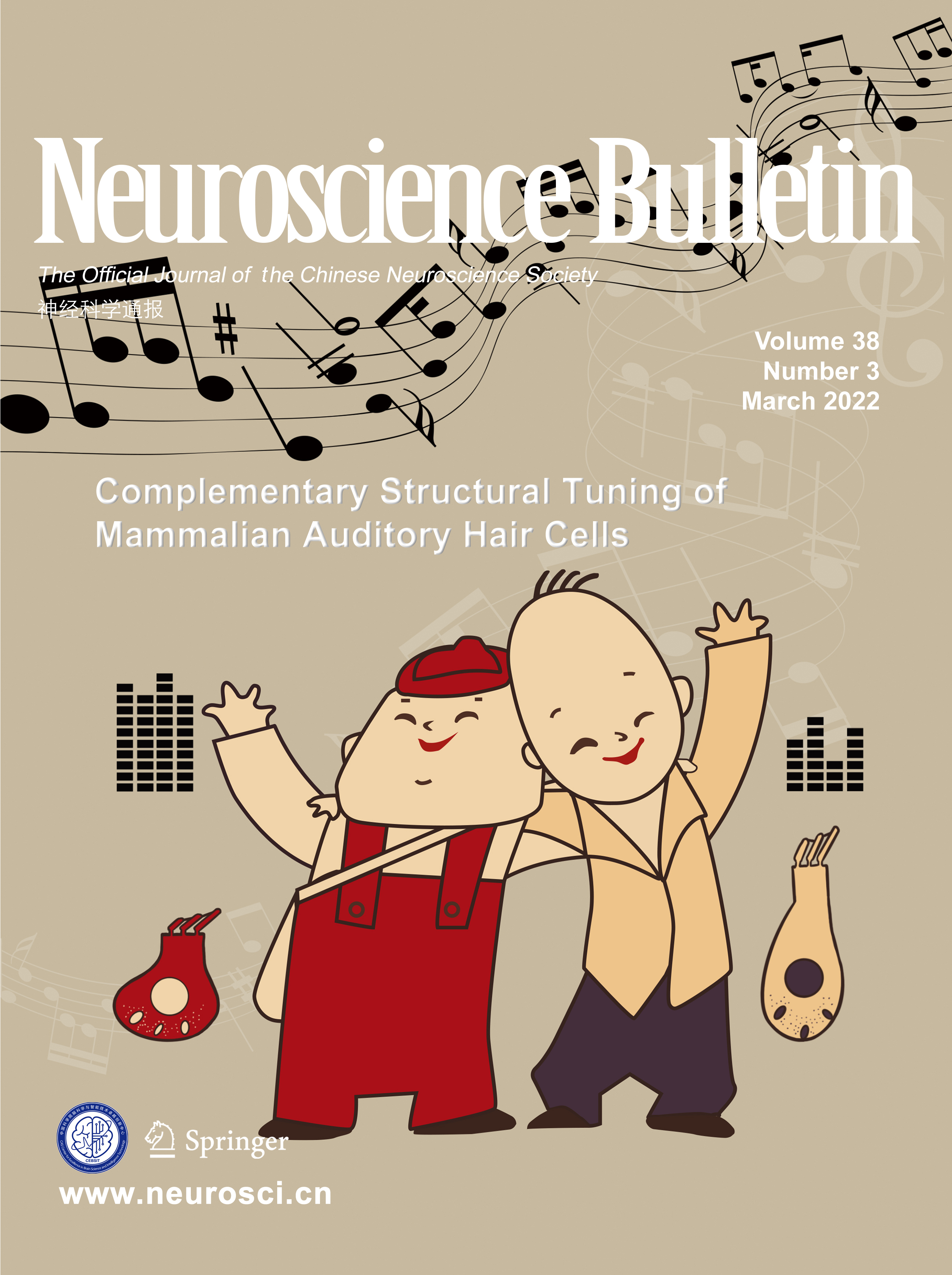Aligned Organization of Synapses and Mitochondria in Auditory Hair Cells
Jing Liu1,2,3 • Shengxiong Wang4,5 • Yan Lu5,6,7,8 • Haoyu Wang5,6,7,8 •
Fangfang Wang5 • Miaoxin Qiu4 • Qiwei Xie9 • Hua Han1,2,3 • Yunfeng Hua5,6,7,8
2022, 38(3):235–248 [
Abstract] [
SpringerLink]
[PDF]
RhoGEF Trio Regulates Radial Migration of Projection Neurons via Its Distinct Domains
Chengwen Wei1 • Mengwen Sun1,2 • Xiaoxuan Sun1 • Hu Meng1 • Qiongwei Li1 • Kai Gao1 • Weihua Yue1,3 • Lifang Wang1 • Dai Zhang1,4,5 • Jun Li1
2022, 38(3):249–262 [
Abstract] [
SpringerLink]
[PDF]
O-GlcNAcylation in Ventral Tegmental Area Dopaminergic Neurons Regulates Motor Learning and the Response to Natural Reward
Ming-Shuo Shao1 • Xiao Yang1 • Chen-Chun Zhang1 • Chang-You Jiang1 • Ying Mao1 • Wen-Dong Xu1 • Lan Ma1 • Fei-Fei Wang1
2022, 38(3):263–274 [
Abstract] [
SpringerLink]
[PDF]
Neuro-Behavioral Dynamic Prediction of Interpersonal Cooperation and Aggression
Wei Wang1,2 • Chao Fu3 • Xiangzeng Kong3 • Roman Osinsky4 • Johannes Hewig5 • Yiwen Wang1,3
2022, 38(3):275–289 [
Abstract] [
SpringerLink]
[PDF]
Polysaccharide Krestin Prevents Alzheimer’s Disease-type Pathology and Cognitive Deficits by Enhancing Monocyte Amyloid-β Processing
Si-Han Chen1,2,3,6 • Chen-Yang He1,2,3 • Ying-Ying Shen1,2,3 • Gui-Hua Zeng1,2,3 • 6 Ding-Yuan Tian1,2,3 • Yuan Cheng1,2,3 • Man-Yu Xu1,2,3 • Dong-Yu Fan1,2,3 • 7 Cheng-Rong Tan1,2,3 • An-Yu Shi1,2,3 • Xian-Le Bu1,2,3,4 • Yan-Jiang Wang1
2022, 38(3):290–302 [
Abstract] [
SpringerLink]
[PDF]
MouseVenue3D: A Markerless Three-Dimension Behavioral Tracking System for Matching Two-Photon Brain Imaging in Free-Moving Mice
Yaning Han1,2 • Kang Huang1,2 • Ke Chen1,2 • Hongli Pan1 • Furong Ju1 •
Yueyue Long1,3 • Gao Gao1,4 • Runlong Wu5 • Aimin Wang6,7 • Liping Wang1,2 •
Pengfei Wei1,2
2022, 38(3):303–317 [
Abstract] [
SpringerLink]
[PDF]
Regulation of Social Memory by Lateral Entorhinal Cortical Projection to Dorsal Hippocampal CA2
Rui Dang1,2 • Yu Zhou1,2 • Yue Zhang1,2 • Die Liu1,2 • Miao Wu1,2 •
An Liu1,2 • Zhengping Jia3,4 • Wei Xie1,2,5
2022, 38(3):318–322 [
Abstract] [
SpringerLink]
[PDF]
White Matter “Matters” in Alzheimer's Disease
Man-Yu Xu1,2 • Zhi-Qiang Xu1,2 • Yan-Jiang Wang1,2,3
2022, 38(3):323–326 [
Abstract] [
SpringerLink]
[PDF]
Loss of C9orf72 in Microglia Drives Neuronal Injury by Enhancing Synaptic Pruning in Aged and Alzheimer’s Disease Mice
Mengmeng Wang1,2 • Yuanyuan Jiang1,2 • Zhihui Huang1,2
2022, 38(3):327–330 [
Abstract] [
SpringerLink]
[PDF]
Do Systemic Infections Contribute to the Pathogenesis of Dementia?
Keenan Sterling1 • Mengen Xing2 • Weihong Song2,3
2022, 38(3):331–333 [
Abstract] [
SpringerLink]
[PDF]
Hemispheric Specialization of the Primate Inferior Parietal Lobule
Sam Vickery1,2 • Simon B Eickhoff1,2 • Patrick Friedrich1
2022, 38(3):334–336 [
Abstract] [
SpringerLink]
[PDF]
Correction to: Comprehensive Management of Daily Living Activities, behavioral and Psychological Symptoms, and Cognitive Function in Patients with Alzheimer’s Disease: A Chinese Consensus on the ...
Jianjun Jia1 • Jun Xu2 • Jun Liu3 • Yongjun Wang4 • Yanjiang Wang5 •
Yunpeng Cao6 • Qihao Guo7 • Qiuming Qu8 • Cuibai Wei9 • Wenshi Wei10 •
Junjian Zhang11 • Enyan Yu12
2022, 38(3):337–338 [
Abstract] [
SpringerLink]
[PDF]

In our cochleae, the inner hair cell (IHC) is responsible for converting sound-induced vibrations into auditory signals via 20–30 ribbon synapses with heterogeneous properties at the basolateral pole. Liu et al. reconstructed mouse IHCs in 3D using state-of-the-art volume electron microscopy and artificial intelligence-assisted segmentation methods. They uncovered two IHC subtypes based on distinct cell body morphology and the spatial gradient of synaptic ribbons. One tall and slim, the other short and stout, just like the two well-known cartoon characters (from early productions of Shanghai Animation Film Studio in the 1960s) on the cover image, they have different “personalities” and “dream occupations”. The fine structural tuning and putative functional diversity of these two IHC subtypes, which are arranged in a staggered manner in the most sensitive mid-cochlear region, may allow complementary coding of a wide range of sound intensities. See pages 235-248. (Cover art by Dr. Yunfeng Hua and Shanghai Animation Film Studio).